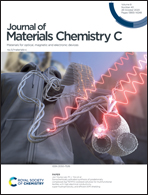Tunable ferroelectricity and antiferromagnetism via ferroelastic switching in an FeOOH monolayer†
Abstract
The exotic effects arising from the interplay between ferroic states in two-dimensional (2D) materials are arousing increasing interest. Using first-principles calculations, we demonstrate the coexistence of three ferroic scenarios: ferroelectric (FE), antiferromagnetic (AFM) and ferroelastic (FA) states in an experimentally-accessible hydroxyl oxidized iron (FeOOH) monolayer. The unique hydrogen-bond network leads to in-plane spontaneous FE polarization with a magnitude of 77.5 pC m−1. The magnetic moments of the spin-polarized Fe ions prefer an AFM ordering with a Néel temperature of 126 K and the easy magnetization axis parallel to the electric polarization direction. Meanwhile, the FeOOH monolayer exhibits prominent ferroelasticity with a large reversible FA strain of 23.6% and a moderate switching energy barrier (0.135 eV per atom), enabling a switchable easy magnetization axis and spontaneous electrical polarization. The multiferroic properties of the FeOOH monolayer not only offer a promising platform for the study of multi-ferroic effects, such as electroelastic and magnetoelastic effects, but also bring about new concepts for next-generation nonvolatile memory devices and multi-stage storage.



 Please wait while we load your content...
Please wait while we load your content...